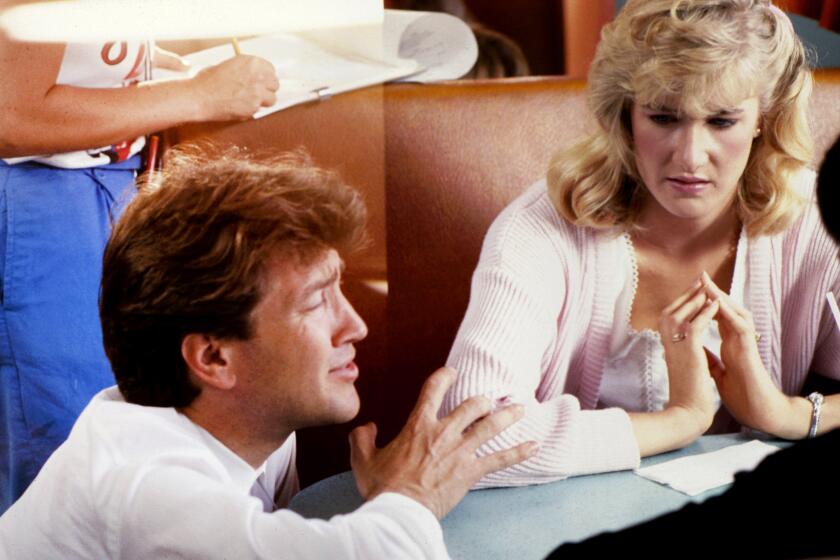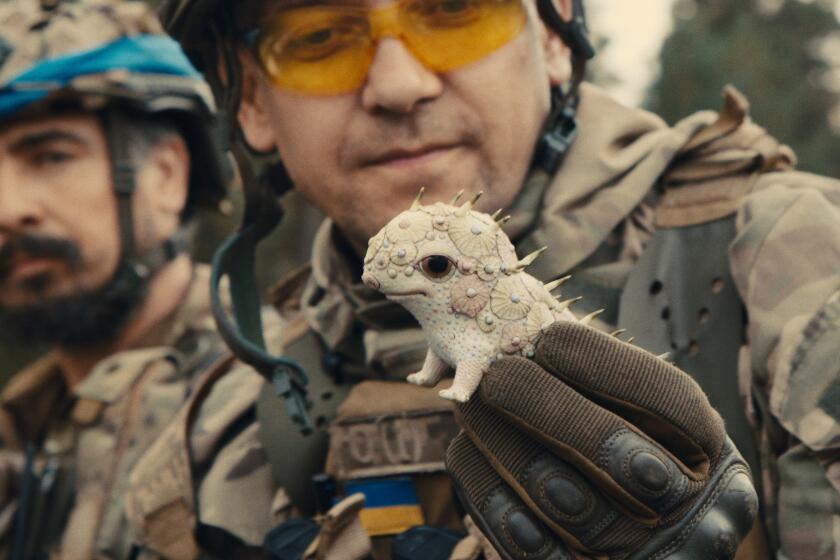Drawing Boards Brimming With Toons : Movies: The success of ‘Beauty and the Beast’ has revitalized animated films. At least 25 features are in various stages of production.
- Share via
Although the animation community heaved a collective sigh of disappointment Monday night when the sentimental favorite “Beauty and the Beast” did not win the Academy Award for bestpicture, the petals have not exactly fallen off the enchanted rose of animation. In fact, the motion-picture field of animation has never been in fuller bloom.
Undaunted members of the animation community say that the Oscar nomination “Beauty and the Beast” received--the first for an animated feature--has brought a new level of respect to the industry, which before its recent resurgence had become something of a ghetto for cheaply produced kids’ fare.
“The best picture nomination is a big gold star for all of us,” said producer-animator John Pomeroy, a partner in Don Bluth Productions. “That nomination puts animation right alongside live-action films as a contender in the marketplace from now on. That benefits us all.”
What’s more, the spectacular box office of “Beauty and the Beast”--the first animated feature to surpass the blockbuster $100-million mark--has blown the theatrical market wide open for animated films.
And just in the nick of time.
Hollywood is awash in a sea of ink and paint that will begin breaking on shore Friday when Bluth’s “Rock-a-Doodle” opens in theaters across the country, followed one week later by the 20th Century Fox release of “FernGully . . . The Last Rainforest.” There are at least six more animated features planned for release this year, most of them from major studios, and another 25 or so in various stages of production or development.
Not surprisingly, Walt Disney Pictures is the leader of the band. Last week Disney moved Peter Schneider, former vice president of feature animation, to the newly created post of president of feature animation to call the toons. Disney also announced plans to more than double the size of its Florida theme-park animation studio this summer to meet the growing demand for animated films.
The objective is for the California studio to continue releasing one animated feature a year, and the Florida facility to begin producing a feature of its own every other year by 1996. The studio currently has eight animated films in development, including the November release of “Aladdin,” the final musical collaboration between Oscar winners Alan Menken and the late Howard Ashman, and next year’s “King of the Jungle,” a contemporary musical with songs by Elton John and Tim Rice.
Disney is even venturing into new animated territory with a couple of uncharacteristic projects. The musical “Nightmare Before Christmas,” a stop-motion movie about a pumpkin-headed skeleton who wants to partake in the Yuletide spirit, is from “Batman” director Tim Burton, with music and songs by Danny Elfman. And Disney has signed Pixar, the studio in Richmond, Calif., that produced the Oscar-winning short “Tin Toy,” to develop the first three-dimensional feature film animated entirely by computer.
Of course, other studios don’t intend to let the new audience for animation escape them. In what’s believed to be a sign of the times, animation producers around Hollywood are now getting their own multi-picture studio deals.
Tom Wilhite and Willard Carroll, whose “Bebe’s Kids,” based on the late Robin Harris’ stand-up comedy routines, opens in July, have a three-picture contract with Paramount. Bluth, a former Disney animator who broke away and created such hits as “An American Tail” and “The Land Before Time” with Steven Spielberg, recently signed a three-picture distribution deal with MGM. The first one, an animated version of the Hans Christian Andersen tale “Thumbelina,” is due this Christmas.
“Fritz the Cat” creator Ralph Bakshi languished in cult obscurity in the later 1970s and early 1980s, producing a dozen adult-themed animated films before burning out and retiring from the business in 1984 to paint. Now he’s back with three studio projects--including Paramount’s July release of “Cool World,” a risque combination of live action and animation starring Kim Basinger. He also expects to close negotiations soon with another studio for a $25-million sequel to his 1977 sci-fi film, “Wizards,” which cost $1 million.
“There are so many different canvases that are now being painted out there,” said Hanna-Barbera Studios President David Kirschner, who is developing a release for Christmas, 1994, called “The Pagemaster,” about a boy who is magically swept into the pages of a library’s fiction section during a rainstorm. “Disney is certainly the Renoir, but there are undiscovered Jackson Pollocks and many others as animation undergoes this rebirth.”
Throughout most of the 1980s, only a handful of animated films were released annually, most of them cut-and-paste compilations of old cartoons or feature-length toy commercials with such merchandising tie-ins as the Transformers or Care Bears. Animators point to 1988’s “Who Framed Roger Rabbit” as the film that first set feature-film animation on fire, and the accolades earned by “Beauty and the Beast” have stoked the flames.
“Beauty and the Beast” was one of the first films to fully exploit new computer-assisted animation techniques--winning Disney and Pixar an Academy Award for technical achievement. The technology has opened up an uncharted world of possibilities for animators, while reducing the time and cost required for traditional animation.
Now, other companies are scrambling to keep up. Hanna-Barbera has brought in computer programmers from Cornell University to tinker with a computer-assisted program the studio is developing in Taipei. American Film Technologies was recently hired by Amblin Entertainment to put its own versatile computer-animation system to feature-film use for the first time on “We’re Back,” a Universal Pictures project based on the Hudson Talbott children’s book about a group of extraterrestrial dinosaurs who visit New York.
There are some concerns, however, that all this animated activity may trash the market as less experienced companies move into the field for a quick kill.
“You hope this doesn’t bring on a lot of copycats and animation ventures that don’t work for the public,” said Joe Taritero, president of American Film Technologies. “Animation is a very delicate entertainment vehicle, and if you start putting out features that are not entertaining, you’re going to blow it.”
But many of the new studio players appear gravely serious about their cartoons as they load up on animated projects and deals that will carry them years into the future, given the lengthy turnaround for animation.
“Family entertainment, specifically animation, is an area we are making a very strong commitment to be in,” said Roger Birmbaum, president of feature productions for Fox. In addition to “FernGully,” Fox is working with Hanna-Barbera on “Once Upon a Forest” for next year and has two other animated projects in the mill.
“We intend to be in this business,” Birmbaum said. “We have a lot to learn. We expect to make some mistakes along the way. But we also expect to learn from our mistakes, and we’re going to hang in there and become part of this.”
The animation movement in the movie business is being mirrored in television. Saturday mornings and weekday afternoons are being flooded with new and better animated products for children, with strong studio leadership from Disney and Warner Bros. While most TV advertising is slumping because of the economy, a frenzy broke out last week as advertisers scrambled to buy time for the 1992-93 children’s TV season. Revenues are expected to hit $500 million, 15% higher than last year.
On cable television, meanwhile, the children’s channel Nickelodeon has invested $40 million to step up production on its popular lineup of original cartoon series that premiered last year. In October, Turner Broadcasting System will launch the 24-hour Cartoon Network, a channel of nothing but animated programming. And USA Network is developing animated characters to spin off into series and specials by 1993.
“Television has finally found the economical ability to produce high-quality animation,” said Gary Krisel, president of animation for Walt Disney Television. “One, because of the success of the syndicated (afternoon) children’s market. Two, because of the role of baby boomers and their children. Three, because there’s a worldwide market now for animation--our television programs play in every country in the world. And four, because home video has proved a significant factor for television, and a huge factor theatrically.”
The burgeoning home video market, where kids’ titles outsell other categories, appears to be the primary reason why animation has become such a hot financial prospect for movie studios. “A lot of young executives are having their own children now,” said Tom Wilhite of Hyperion Pictures. “When they see their kids watching an animated film on video 10 times in a row, they realize that their children can’t be the only children in America doing that.”
Most studio-released animated films cost between $15 million and $25 million to make--although Disney’s films go higher--and generally need to gross about three times their negative cost in the box office to make money. But thanks to home video, even a ho-hum animated theatrical release can generate revenue.
Bluth’s “All Dogs Go to Heaven,” for example, grossed a modest $23.4 million theatrically in 1989. Then the film became a considerable hit on video, selling more than 4 million copies at $19.95. On the average, the lion’s share of home-video revenue--about 60%--goes back to the studio.
“The video rights are one of the precious stones guarded by the studios and distribution houses,” said Pomeroy of Bluth Productions. “That’s the bigger cash pie than theatrical.”
Because top animation producers don’t usually wield the clout in Hollywood that top live-action producers do, Pomeroy said that animators frequently see lower profits. “I hope the studios will start allowing for a better profit-participation deal on video products as the animation market opens up,” he said.
More to Read
Only good movies
Get the Indie Focus newsletter, Mark Olsen's weekly guide to the world of cinema.
You may occasionally receive promotional content from the Los Angeles Times.










